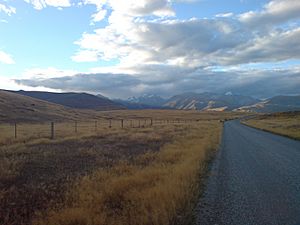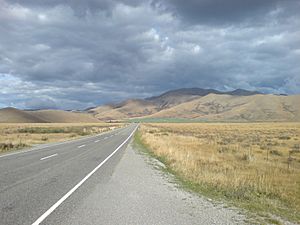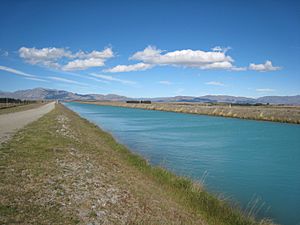Mackenzie Basin facts for kids
The Mackenzie Basin, also known as the Mackenzie Country (or Te Manahuna in Māori), is a large, flat area of land in the middle of the South Island of New Zealand. It's like a huge bowl surrounded by mountains.
This basin is the biggest of its kind in New Zealand. For a long time, it was mostly known for sheep farming. Today, not many people live here, but it's a very popular place for tourists to visit.
The area got its name in the 1850s from a shepherd named James Mckenzie. He was from Scotland and was caught for supposedly stealing sheep. He used to herd his sheep in this quiet, empty land. Even though Māori people had lived here sometimes before, it was mostly empty when Mckenzie was there. After he was caught, the land was quickly divided up for new sheep farms in 1857.
Contents
Geography of the Mackenzie Basin

The Mackenzie Basin stretches about 100 kilometers (62 miles) from north to south. It is also about 40 kilometers (25 miles) wide from east to west. The tall Southern Alps mountains form its western side. The whole basin is located within the South Canterbury area.
You can reach the basin by driving on State Highway 8. You can come from the north through Burkes Pass or from the south through the Lindis Pass. Another way is to use State Highway 83 through the Waitaki Valley from the east. The land is generally highest in the north and slopes down towards the south.
The Waitaki River drains all the water from the basin. Important rivers that flow through the Mackenzie Basin include the Ahuriri, the Hakataramea, and the Tekapo. There are also several beautiful lakes here. These include Ōhau, Pukaki, Alexandrina, and Tekapo. Some artificial lakes, created for making electricity, are also in the basin. These are Ruataniwha, Benmore, and Aviemore.
Life and Fun in the Mackenzie Basin
The Mackenzie Country doesn't have many people living in it. There are only four main towns: Lake Tekapo, Mount Cook Village, Twizel, and Omarama. Each of these towns has less than 1,000 people.
This area is famous for its huge lakes formed by glaciers and its mountains covered in snow. Tourists and skiers especially love to visit.
There are a few small ski fields that are popular with people from nearby areas. These include Ōhau skifield near Omarama, and Roundhill and Mount Dobson Ski Areas at Lake Tekapo.
The Mackenzie Country is also a popular spot for filming movies and TV shows. Parts of Peter Jackson's famous Lord of the Rings and Hobbit movies were filmed here.
Another popular activity in the Mackenzie Basin is gliding. This is where people fly in planes without engines, using air currents. The area even hosted a Gliding World Cup event in 1995. There are several gliding clubs and airfields, and many pilots who enjoy flying gliders here.
Aoraki Mackenzie International Dark Sky Reserve
The Mackenzie Basin has a very clear, dry, and dark sky. This makes it a perfect place for looking at stars and planets. Many important astronomy places are located here. One of them is the University of Canterbury's Mount John University Observatory, which is New Zealand's main place for studying space. There are also several smaller observatories for people who enjoy astronomy as a hobby.
More and more tourists are coming to the area just to look at the stars. New businesses are starting up near Lake Tekapo, Mount Cook village, and Omarama to help people enjoy the night sky. Every June, there's a special mid-winter star party held at the Omarama airfield.
In June 2012, a huge area of land, including Aoraki / Mount Cook National Park and the Mackenzie Basin, was named the Aoraki Mackenzie International Dark Sky Reserve. This means it's a special place protected for its dark skies. When it was named, it was the biggest reserve of its kind in the world. It was also the only one in the Southern Hemisphere.
Environmental Challenges
The plants that originally grew in the Mackenzie Basin have changed a lot over time. This happened because of fires started by early Māori and European settlers. Later, farming and animal pests also changed the land.
A large network of canals was built to create hydroelectric power (electricity from water). These canals caused problems for the black stilt (or kakī), which is a rare river bird. To help this bird, a special program was started to breed them safely. The Department of Conservation manages this program.
The Mackenzie Basin is also a place where "wilding conifers" grow very quickly. These are like weed trees that can spread over large areas. They can grow so thickly that they stop native plants from growing and reduce the amount of land available for animals to graze. Some areas have plans to control these trees.
Rabbits are another common problem in the area. They are an invasive species (animals that are not native and cause harm) and affect both farms and the natural environment. The number of rabbits went down after a disease helped control them. However, their numbers are now growing again. The Department of Conservation plans to use special bait to control the rabbit numbers. This is important because the Mackenzie Basin has many rare plant species that need protection.
There is also a high demand for water to irrigate (water crops) in the Mackenzie Basin. Many people want to use water to grow plants on their land. However, some local people and the Department of Conservation are worried about how this might affect the environment. They are also concerned it might conflict with a plan to create a special "Mackenzie Basin Drylands Park" to protect the unique dryland environment.




